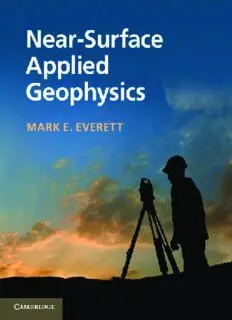
Near-Surface Applied Geophysics PDF
Preview Near-Surface Applied Geophysics
Near-Surface Applied Geophysics Just a few meters below the Earth’s surface lie features of great importance, from geological faults which can produce devastating earthquakes, or migrating contaminant plumesof hazardous industrialwaste, tolost archaeological treasures! FueledbythegrowingneedforcarefulmanagementoftheEarth’ssubsurfaceresources, traditional geophysical methods designed for deep-exploration targets have been comple- mented by significant advances in near-surface applied geophysics techniques and inter- pretation theory. This book provides a refreshing, up-to-date exploration of the theoretical foundations andthelatestdevelopmentsinnear-surfacetechniques.Itisclearbutrigorous,explaining theoryandpracticeinsimplephysicalterms,supportedbyintermediate-levelmathematics. Techniquescoveredincludemagnetics,resistivity,seismicreflectionandrefraction,surface waves,inducedpolarization,self-potential,electromagneticinduction,ground-penetrating radar,magneticresonance,interferometry,seismoelectricmethods, andmore.Sectionson data analysis and inverse theory are provided and chapters are amply illustrated by case studies, providing a resource that gives students and professionals the necessary tools to plan, conduct,andanalyze a near-surface geophysical survey. This is an important textbook for advanced undergraduate and graduate students in geophysics,andavaluablereferenceforpracticinggeophysicists,geologists,hydrologists, archaeologists, civil and geotechnical engineers, and others who use geophysics in their professionalactivities. MarkE.Everettis currently the Howard Karren Endowed Professor and Graduate Director in the Department of Geology and Geophysics at Texas A&M University, and was a GuestProfessorin2010attheInstitutfurGeophysik,ETHZurich.HeoperatestheNear- Surface Applied Geophysics laboratory at Texas A&M and has conducted geophysical field work in many locations including the Normandy D-Day landing site in France and on the island of Alcatraz. Dr Everett is on the editorial boards of Geophysics and Geophysical Journal International and has received the Texas A&M College of Geoscience Dean’s Research Achievement Award. He is a fellow of the Royal Astronomical Society and a member of the American Geophysical Union and Society of Exploration Geophysicists. Dr Everett is a frequent consultant to the oil and gas, environmental, and geotechnical engineering sectors of industry, holds a professional licensetopracticegeophysicsintheStateofTexas,andenjoyscontributinghistimeand expertise to local historical archaeological projects. Praise for this book: “Thisbookprovidesanexcellentintroductiontotherapidlyemergingfieldofnear-surface geophysics. The state-of-the-art material covered in the text will not only be helpful for undergraduate and graduate students, but it will also serve as a valuable reference for practitioners.” – Professor Hansruedi Maurer, ETH Zürich “Agreatbookforteachingundergraduatestheessenceofallgeophysicaltechniquesused in near surface exploration; the mix of theory, practice and case studies is just right for students.” – Professor Graham Heinson, School of Earth and Environmental Sciences, The University ofAdelaide “Thisisanexcellenttextforadvancedgeophysicsundergraduateandgraduatestudents,a valuable resource for scientists and engineers involved in characterizing the earth’s near surface,and the material fills a voidin thebookshelves ofmany geoscientists.” – Professor Doug Oldenburg, University of British Columbia Near-Surface Applied Geophysics MARK E. EVERETT TexasA&MUniversity cambridgeuniversitypress Cambridge,NewYork,Melbourne,Madrid,CapeTown, Singapore,SãoPaulo,Delhi,MexicoCity CambridgeUniversityPress TheEdinburghBuilding,CambridgeCB28RU,UK PublishedintheUnitedStatesofAmericabyCambridgeUniversityPress,NewYork www.cambridge.org Informationonthistitle:www.cambridge.org/9781107018778 ©MarkE.Everett2013 Thispublicationisincopyright.Subjecttostatutoryexception andtotheprovisionsofrelevantcollectivelicensingagreements, noreproductionofanypartmaytakeplacewithout thewrittenpermissionofCambridgeUniversityPress. Firstpublished2013 PrintedandboundintheUnitedKingdombytheMPGBooksGroup AcatalogrecordforthispublicationisavailablefromtheBritishLibrary LibraryofCongressCataloguinginPublicationdata Everett,MarkE.,1961– Near-surfaceappliedgeophysics/MarkE.Everett,TexasA&MUniversity. pages cm Includesbibliographicalreferencesandindex. ISBN978-1-107-01877-8(Hardback) 1. Geophysics–Methodology. I. Title. QC808.5.E942013 550.7204–dc23 2012036494 ISBN978-1-107-01877-8Hardback CambridgeUniversityPresshasnoresponsibilityforthepersistenceor accuracyofURLsforexternalorthird-partyinternetwebsitesreferredto inthispublication,anddoesnotguaranteethatanycontentonsuch websitesis,orwillremain,accurateorappropriate. To Elaine, Taylor, and Laura Contents Preface page xiii Acknowledgments xiv 1 Introduction 1 1.1 Workflow 2 1.2 Some applicationsof near-surface geophysics 3 1.3 Communication ofuncertainties 9 1.4 Outlineof the book 11 2 Dataanalysis 12 2.1 Information 12 2.2 Sensors 14 2.3 Frequency response 15 2.4 DiscreteFourier transform 17 2.5 Filtering 22 2.6 Convolution 24 2.7 Samplingand aliasing 26 2.8 Data windows andspectral analysis 26 2.9 De-spiking time series 28 2.10 Continuous wavelet transform (CWT) 30 Problems 33 3 Magnetics 34 3.1 Introduction 34 3.2 Fundamentals 36 3.3 Instrumentation 41 3.4 Magneticgradiometry 44 3.5 Geomagnetic field 44 3.6 Total-fieldanomaly 49 3.7 Interpretation of magnetic anomalies 49 3.8 Reduction tothe pole 52 3.9 Depth rules 57 3.10 Magneticproperties of rocks, soils,and buriedsteel objects 57 3.11 Remanentmagnetization 59 3.12 Image-enhancementfilters 60 3.13 Upward continuation 62 vii viii Contents 3.14 Euler and Werner deconvolution 64 3.15 Illustrative casehistories 67 Problems 68 4 Electrical resistivity method 70 4.1 Introduction 71 4.2 Fundamentals 72 4.3 Sensitivity functions 78 4.4 Multi-layer models 80 4.5 Azimuthal resistivity 84 4.6 Resistivity pseudosections 87 4.7 Electrical-resistivitytomography (ERT) 87 4.8 Electrical properties of rocks 90 4.9 Electrical–hydraulic field-scalecorrelation studies 93 4.10 Optimal electrode placement 96 4.11 Underwater resistivitytechniques 99 4.12 Illustrative casehistories 100 Problems 102 5 Induced polarization and self-potential 104 5.1 Induced polarization (IP): introduction 105 5.2 Phenomenological resistivitydispersionmodels 107 5.3 Electrode, membrane, and interfacialpolarization 109 5.4 IPresponse and subsurface geological processes 111 5.5 Non-polarizing electrodes 112 5.6 IPillustrated case history 112 5.7 Self-potential (SP): introduction 114 5.8 Physical mechanisms 115 5.9 Interpretation ofSP measurements 117 5.10 Continuouswavelet transform analysis 119 5.11 SP illustrated case history 123 Problem 124 6 Seismic reflectionand refraction 125 6.1 Introduction 125 6.2 Stress and strain 128 6.3 Wave motion 131 6.4 Seismic waves and elastic moduli 132 6.5 Seismic velocity of geomaterials 134 6.6 Reflectionand refraction atan interface 136 6.7 Diffraction 139 6.8 Analysis of idealized reflection seismograms 139 6.9 Vertical andhorizontal resolution 144 ix Contents 6.10 Common midpoint profiling 148 6.11 Dip moveout 150 6.12 Attenuation 153 6.13 Seismicrefraction 155 6.14 Practicalconsiderations 160 6.15 Seismicdata processing 164 6.16 Ray-path modeling 174 6.17 Illustrated case studies 177 Problems 180 7 Seismicsurface-wave analysis 182 7.1 Rayleigh waves 182 7.2 Dispersion 184 7.3 Rayleigh-wave propagation in a multi-layer system 185 7.4 Spectralanalysisof surfacewaves(SASW) 187 7.5 Multichannel analysis ofsurface waves (MASW) 190 7.6 Inversionof R-wavedispersion characteristics 192 7.7 Microtremor andpassive studies 195 7.8 Illustrated case histories 197 8 Electromagnetic induction 200 8.1 Introduction 200 8.2 Fundamentals 204 8.3 The skin effect 206 8.4 Inductively coupled LRcircuits 208 8.5 Terrain conductivitymeters 213 8.6 Time-domainEM induction 219 8.7 Finite-source excitationof a layered Earth 223 8.8 Plane-wave excitation methods: VLF, RMT,CSMT 224 8.9 Airborne electromagnetics 228 8.10 EM responses ofrough geological media 230 8.11 Anisotropy 232 8.12 Illustrated case histories 234 Problems 238 9 Ground-penetrating radar 239 9.1 Fundamentals 241 9.2 Dielectric constantand electricalconductivity 245 9.3 Dielectric properties ofrocks and soils 247 9.4 Resolution 250 9.5 Data acquisition 250 9.6 Basic GPR data processing 252 9.7 Advanced GPRdata processing 256
